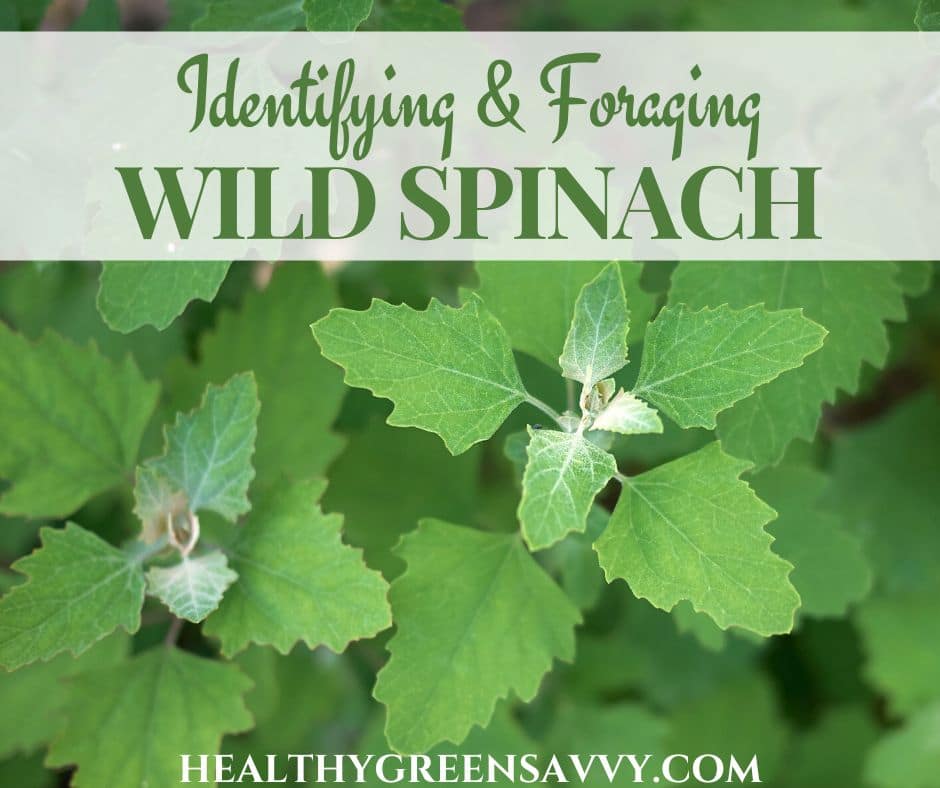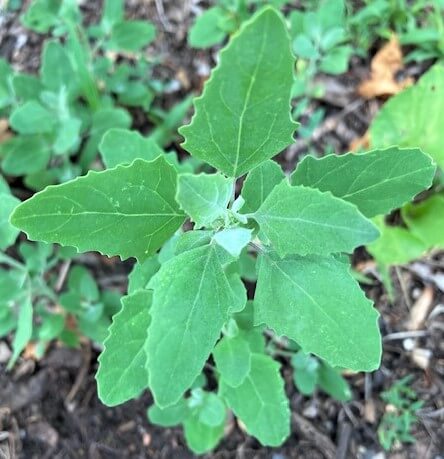Last Updated on October 23, 2024
Wild spinach (also commonly called lambsquarters or lamb’s quarters, white goosefoot, or pigweed) is a tasty and versatile edible wild plant that’s probably growing in your garden already. Here’s what to know about identifying and foraging wild spinach.

WHAT IS WILD SPINACH?
Also known as common lambsquarters, lamb’s quarter, white goosefoot, bathua, fat hen, and pigweed, wild spinach (Chenopodium album) is a common wild plant you’ve no doubt pulled from your garden.
Well, now you can stop! A relative of spinach in the amaranth family, wild spinach is a nutritious plant to add to your salad bowl, one of many underappreciated weeds you can eat.
With so many wonderful wild plants already growing in abundance in my garden, I hadn’t paid much attention to the lambsquarters that popped up here and there over the course of the season. Last summer, however, while conducting interviews for an article on some very cool front yard vegetable gardeners, I decided I needed to tune in to this plant others were raving about.
Here’s why: In the upper midwest, we often have very short springs and autumns, with winter turning quickly to summer and vice versa. It often remains too cold to plant anything till the end of April, and then the heat can turn up too high for cool-weather spinach by mid-May. Which means we don’t have much of a chance for a real spinach crop until fall.
But lambs quarters will grow happily in the heat loooong after your spinach bolts. All season, actually.
Here’s what to know about growing spinach if you have a more favorable climate. If you don’t, give wild spinach a try and you may never bother trying to plant spinach again.
For those of us who love spinach, wild spinach is a gift. Not only can it manage in summer heat, it comes up all by itself, without the need for distracted gardeners to remember to plant or water fussy seeds.
In The Forager’s Harvest, Samuel Thayer writes of lambsquarters: “For those who wish to reap where they did not sow, they are still among the most useful plants to know.” Agreed!
Foraging expert ‘Wildman’ Steve Brill calls lambs quarters “one of the best sources of beta-carotene, calcium, potassium, and iron in the world; also a great source of trace minerals, B-complex vitamins, vitamin C, and fiber.”
Another plant sometimes called wild spinach is sea beet (Beta vulgaris ssp. maritima), also a member of the amaranth family, but in the Beta genus like closely-related chard.
IS LAMBSQUARTERS GOOD FOR YOU?
Wild spinach is a very nutritious plant, one of the most nutrient-dense you can find or cultivate. It’s rich in a number of vitamins, and minerals, especially potassium, calcium, and vitamin A, according to the USDA.
Caution: Like its cousin spinach, common lambsquarters is high in oxalic acid and nitrates, and should be consumed in moderation, especially by those sensitive to these substances. It takes up nitrates readily from the soil, so avoid harvesting from somewhere that fertilizer has been used.
WHAT DOES LAMBS QUARTERS TASTE LIKE?
Like cultivated spinach, lambsquarter is a mild-tasting green, without the strong bitterness of something like dandelion leaves or arugula. Fresh-picked raw leaves have a pleasant green flavor that would work in a salad with other leafy greens.
Sauteed or cooked in soup, the flavor mellows further. Top notch with pasta and garlic, like in this recipe featuring spring garlic and asparagus.
HOW TO IDENTIFY WILD SPINACH / LAMBS QUARTER IDENTIFICATION
Lambsquarters have a wide range, growing on every continent except Antarctica. The Peterson Guide to Medicinal Plants and Herbs calls it “one of the most successful cosmopolitan weeds in the world.” Lambsquarter plants like disturbed soil and will often pop up in gardens, farm fields, parks, and any other place they can really.
How to identify lambsquarters plants

Leaves
Leaves resemble the webbed foot of a goose (hence the name ‘goosefoot’), with irregular teeth or lobes. Smaller leaves may be smoother. Covered with a white fuzz or powdery coating, especially on new growth, leaves grow in an alternate pattern on the stem.

Stems often have reddish stripes, as you can see in the photo above.
Flowers
Flowers are subtle, with 5 stamens and sepals. The developing florets can be cooked like broccoli.

Growth Habit
Lambsquarters plants can grow over 6 feet tall (commonly 3 to 5 feet), and unlike many plants where you need to catch them early, the new growth of wild spinach can be harvested all season long. If you have a large plant, you can pluck the central tip and your lambsquarters plant will send out side shoots — which means more wild spinach for you!
If you’re newer to foraging check out some other wild edible plants suggested for beginners.
LAMBSQUARTERS LOOK ALIKES
There are several species of chenopod and subspecies of common lambsquarters (Chenopodium album), but they’re all edible.
Orache (Atriplex hortensis), another member of the amaranth family, has a very similar white coating but a different leaf shape. It’s also edible, though people don’t agree on how delicious it is. Description and images can be found here.
The Mexican herb epazote is another related plant, but a little sniff should help you distinguish lambs quarter plants from epazote. Epazote has a very powerful scent. Here’s more about identifying epazote and some cautions in using it from Eat the Weeds.
Another relative most commonly known as strawberry blite or strawberry spinach has smaller, pointier leaves that I think have better flavor than common lambsquarters. However, they’re not as plentiful and would be hard to get a decent serving of. Their abundant berries, on the other hand, make this plant one worth knowing. Find out more about foraging strawberry blite.
Black nightshade and belladonna bear some similarities to white goosefoot, but lack the characteristic white powdery coating. While some nightshades are safe to consume, some are in fact, deadly, hence the name deadly nightshade. More on identifying these plants here.
Note that the name pigweed is also sometimes applied to wild amaranth, another edible member of the amaranth family.
–> Remember, you should ALWAYS consult a good field guide and make sure you’ve correctly identified any wild plant.
Consider taking a local foraging class, or find one online. The Herbal Academy’s foraging course will help you gain skills identifying plants and wildcrafting.
FORAGING & HARVESTING WILD SPINACH / LAMBSQUARTERS PLANT
The young tips of the plant are the tastiest and easiest to harvest. You don’t need to harvest individual leaves; just use the whole cluster of leaves still attached to the stem. Young plants can be used whole in cooking until they reach 6 to 12 inches tall. After that, stems become tough, and you’ll want to harvest only the younger tips and leaves.
If there’s a lot of white powder, Thayer recommends washing and rubbing off as much you can before eating. He notes that people whose tongues get irritated by eating too much spinach will have the same problem with lambs quarters, but in smaller amounts it shouldn’t pose a problem.
You can also use the flowering buds like broccoli raab and harvest the tiny seeds, which resemble goosefoot’s cousin quinoa. Gathering the seeds and sifting out the indigestible chaff is reportedly somewhat laborious. Thayer recommends using maple leaf goosefoot if you’re going to try.
Collect the seed clusters after they have turned brown in late fall. Clip clusters into a paper bag. Use a screen to separate seeds from chaff as you rub the clusters with your hands to release the tiny black seeds. They should fall through the screen, which will retain the chaff.
If you don’t have easy access to wild spinach, you can easily cultivate it in your garden by harvesting seeds from the lambsquarters plants you’ll almost certainly find in a casual walk through your neighborhood. Or perhaps a neighbor has some growing in their garden who would let you transplant a few to yours.
You can also buy seeds online. A variety called ‘magenta spreen‘ has beautiful magenta coloring in the growing tips.
HOW TO USE WILD SPINACH / LAMBSQUARTERS
Lambsquarters is also known for taking up contaminants, so be sure not to harvest it from soils you know to contain high levels of heavy metals or chemical pesticides.
Like quinoa, the seeds are covered with a protective coating of bitter-tasting saponins. Plan to soak or rinse seeds if you choose to harvest them, and then you can save the rinse water to use as a natural soap or toss in your garden to irritate any lurking jumping worms.
♦ You can use leaves and whole tender tips fresh in salads, or steamed or sauteed on their own or with other greens.
♦ Leaves can be tossed into smoothies, along with other wild greens like purslane. Here’s my go-to purslane smoothie recipe and 50 more delicious healthy smoothie recipes if you need some inspiration.
♦ Long used as a potherb (a green plant cooked in soups and stews), you can use lambs quarters as you would spinach in any cooked dish. Add toward the end of cooking to keep leaves from getting mushy.
♦ It can also sub for spinach in this easy, protein-packed spinach dip.
♦ One of my favorite ways to use mild wild greens (e.g., goosefoot, wood nettle, or Virginia waterleaf) is to cook in frittatas or omelets. You could add stronger flavored greens like dandelion or garlic mustard.
Wild spinach has medicinal properties as well. Several Native American tribes used it for digestive issues, skin complaints, and to prevent scurvy. The Peterson Guide notes that a tea made from lambs quarter leaves has been used to address diarrhea and can be used as a poultice to treat insect bites and burns.
PRESERVING WILD SPINACH
Lambsquarters can be dehydrated or blanched and frozen as you would spinach. Here’s how to freeze spinach, wild or otherwise, two easy ways. This post on preserving herbs has more information on different options for dehydrating and freezing your foraged wild greens.
RECIPES USING WILD SPINACH
Here are a few recipes to get you started enjoying this versatile wild green:
♦ If you haven’t made fritattas before, here’s one calling for lambs quarters from Food 52.
♦ Here’s a simple sauteed lambs quarter recipe from Eat the Planet.
♦ Here’s a gratin recipe from Epicurious.
♦ This recipe for roasted lambs quarters stems from Edible Wild Food looks really good!
♦ Try a wild spinach pesto with basil like this one from Pioneering Today.
♦ Here’s a cream of lambs quarters soup from Kitchen Vignettes.
If you need more ideas, be sure to check out this huge collection of lambs quarter recipes. Wild spinach would work in many of these amaranth leaves recipes as well.
Below are some other collections of wild food recipes to explore:
Pin to save this information on wild spinach for later!

Additional goosefoot photo credits in cover and pins: seven75

Susannah is a proud garden geek and energy nerd who loves healthy food and natural remedies. Her work has appeared in Mother Earth Living, Ensia, Northern Gardener, Sierra, and on numerous websites. Her first book, Everything Elderberry, released in September 2020 and has been a #1 new release in holistic medicine, naturopathy, herb gardening, and other categories. Find out more and grab your copy here.



 Hi, I'm Susannah, a garden geek, energy nerd, and fan of healthy food and natural remedies. Need some simple, practical solutions for living healthier and greener? You've come to the right place! More about me and my green projects
Hi, I'm Susannah, a garden geek, energy nerd, and fan of healthy food and natural remedies. Need some simple, practical solutions for living healthier and greener? You've come to the right place! More about me and my green projects
Leave a Reply